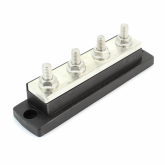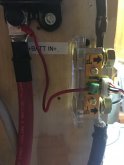You are using an out of date browser. It may not display this or other websites correctly.
You should upgrade or use an alternative browser.
You should upgrade or use an alternative browser.
Shunts
- Thread starter MrNatural22
- Start date
b.james
New Member
Well I dont . Its a very small current.
MrNatural22
?SW sunshine =⚡️⚡️lit up thru the darkness✌️
My meter/shunt came with a fused line. I am a proponent of fuses and would add a fuse personally. 100ma fuse would probably be fine although check with the manufacturer.
Yeah better safe than sorry as the lesson goes. Easily done
TCgreg
Solar Enthusiast
- Joined
- Sep 21, 2019
- Messages
- 116
I'm sure you could buy just a holder and a fuse but kits like this are so inexpensive and you have all the parts for future projects.
https://www.amazon.com/5x20mm-Holde...WM9VJ5W5Z93&psc=1&refRID=2AT207NFPWM9VJ5W5Z93
https://www.amazon.com/5x20mm-Holde...WM9VJ5W5Z93&psc=1&refRID=2AT207NFPWM9VJ5W5Z93
MrNatural22
?SW sunshine =⚡️⚡️lit up thru the darkness✌️
I have a box full of automotive odds and ends gathering dust for years so I probably have a few in that stash.I'm sure you could buy just a holder and a fuse but kits like this are so inexpensive and you have all the parts for future projects.
https://www.amazon.com/5x20mm-Holde...WM9VJ5W5Z93&psc=1&refRID=2AT207NFPWM9VJ5W5Z93
that’s why guys never throw stuff out cuz “someday” we’ll find a use for it. Ive learned to hide things like that from the ole lady or she’ll see it as trash and sh!t cans it if I don’t. LOL
eddie1261
Solar Enthusiast
Is there a difference between a shunt and a bus bar?
TCgreg
Solar Enthusiast
- Joined
- Sep 21, 2019
- Messages
- 116
The word shunt has various meanings but in this context a shunt is a device that passes electrical current with a very small amount of resistance. By measuring this very small voltage drop across the shunt a meter can determine the current passing back and forth across it. A shunt allows us to know how many amps are left in a battery bank. It is essentially a gas gauge for the battery.Is there a difference between a shunt and a bus bar?
A busbar is typically a distribution bar where a circuit can be shared without stacking or otherwise fastening the conductors to each other. It does not do any measuring of current.
Here is a typical busbar one might use in a DC system. You can attach your positive or negative battery connection and then add other cables for other uses to the studs.

An example of a shunt is found on the OP post.
eddie1261
Solar Enthusiast
So a shunt is a bus bar with the ability to send remaining power info to a meter? Like the screen on my MPP shows me? So if I had a big enough system to require this (I don't have anywhere near the amount of connections that I'd need to do this) I could use a bus bar because my all-in-one MPP unit has a display screen showing me remaining power level?
Rider
Solar Addict
ie, calibrated.but in this context a shunt is a device that passes electrical current with a very small amount of resistance.
svetz
Works in theory! Practice? That's something else
Does the small wire to power the meter on a shunt have to be fused?
A fuse isn't for the normal day-to-day current. It's for the oops current. So the fact that it normally has a small current isn't important.
If the battery has 450 cold cranking amps, that's what would go through that tiny wire during a short. At those sort of amps, the wire would probably act as a fuse. Is it a "danger"? Depends on what's around it that might catch fire, if the smoke from the wire insulation would create toxins (e.g., cyanides), and whether it would disconnect fast enough to prevent damage to other things far more valuable than a 10 cent fuse.
Update:
<sigh> Late to the party again!Yeah better safe than sorry as the lesson goes. Easily done
TCgreg
Solar Enthusiast
- Joined
- Sep 21, 2019
- Messages
- 116
Since a shunt only has cable connections to be inline with the negative battery cable I wouldn't call it a buss bar. You definitely don't want anything other than the battery cable on the battery side. You could stack negative load cables on the load side but it's not really designed as a distribution bus. It will work fine though if that's what you want to do. With a shunt ALL loads must be on the load side of the shunt and not connected to the battery. Otherwise it won't be counting all current.
The shunt doesn't send remaining power to the meter. The meter captures the current that passes across the shunt in both directions. The meter interprets that data to tell the batteries state of charge. Think of it as jar of marbles. (your battery) As marbles are moved from the jar it counts them leaving. As marbles are coming in from a charging source like solar it counts those as well. It knows how full or empty the jar (battery) is at any given time.
A bus bar is like a power strip you might use for your computer. One plug turns into multiple plugs. The bus bar just gives you a place to land additional wires that you would normally have to bolt together. It doesn't increase any of the components capacities.
The shunt doesn't send remaining power to the meter. The meter captures the current that passes across the shunt in both directions. The meter interprets that data to tell the batteries state of charge. Think of it as jar of marbles. (your battery) As marbles are moved from the jar it counts them leaving. As marbles are coming in from a charging source like solar it counts those as well. It knows how full or empty the jar (battery) is at any given time.
A bus bar is like a power strip you might use for your computer. One plug turns into multiple plugs. The bus bar just gives you a place to land additional wires that you would normally have to bolt together. It doesn't increase any of the components capacities.
TCgreg
Solar Enthusiast
- Joined
- Sep 21, 2019
- Messages
- 116
A shunt is only needed if you desire to know with a high degree of certainty where your batteries remaining capacity is at.Is a shunt needed if the charge controller has a display that will be visible in my system?
Most charge controller give you state of charge based on the voltage it is reading. This is a very inaccurate way to measure state of charge unless the battery is completely disconnected from all loads and charging sources and allowed to rest a while. Momentary voltage of a battery is highly affected by loads and charging. Your solar charger may indicate 90% full when in reality it is practically empty. Why? Because your solar it hitting it with 13+ volts and your solar charger has no way of knowing. Likewise your battery could be full and you are running some devices that are sagging your voltage down to 12v. Now the Solar charger thinks you are at 50% or less.
The shunt is not affected by battery voltage. It measures state of charge as I described in my last post ^
eddie1261
Solar Enthusiast
The power strip analogy makes sense. With a background in performing music, I look at that as a power strip in reverse, like a mixer. 6 keyboards plug into my mixer, one out to the house PA. Except in this case, it would count decibels. LOL!!
Also, the size and scope of my system renders this unnecessary. In my tiny trailer I could get by with a 50ah battery, and I have a 100ah.
Also, the size and scope of my system renders this unnecessary. In my tiny trailer I could get by with a 50ah battery, and I have a 100ah.
Makes total sense...Thank you!A shunt is only needed if you desire to know with a high degree of certainty where your batteries remaining capacity is at.
Most charge controller give you state of charge based on the voltage it is reading. This is a very inaccurate way to measure state of charge unless the battery is completely disconnected from all loads and charging sources and allowed to rest a while. Momentary voltage of a battery is highly affected by loads and charging. Your solar charger may indicate 90% full when in reality it is practically empty. Why? Because your solar it hitting it with 13+ volts and your solar charger has no way of knowing. Likewise your battery could be full and you are running some devices that are sagging your voltage down to 12v. Now the Solar charger thinks you are at 50% or less.
The shunt is not affected by battery voltage. It measures state of charge as I described in my last post ^
Similar threads
- Replies
- 8
- Views
- 307
- Replies
- 44
- Views
- 2K
- Replies
- 5
- Views
- 302



